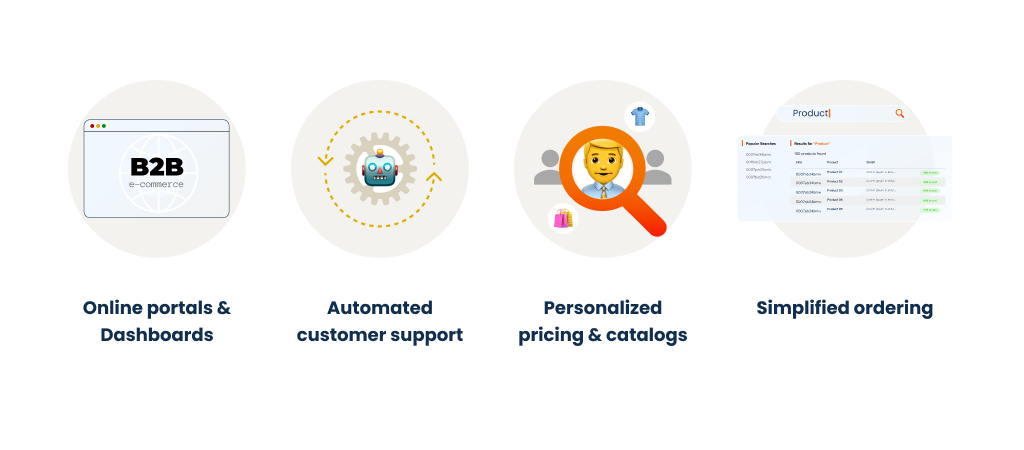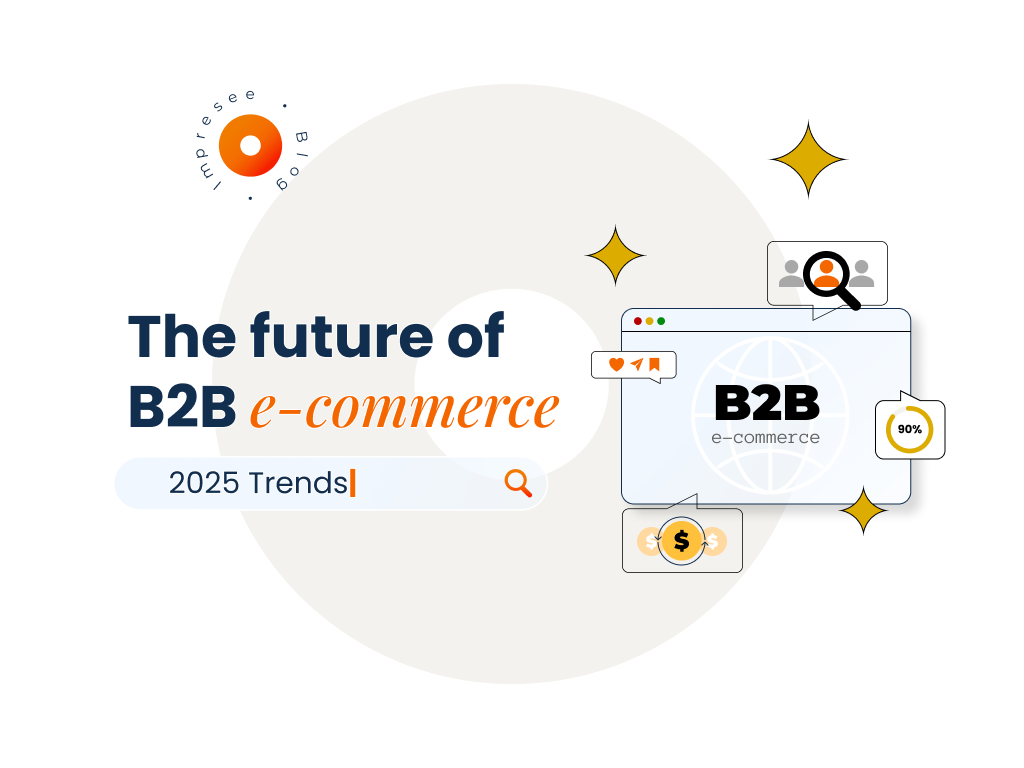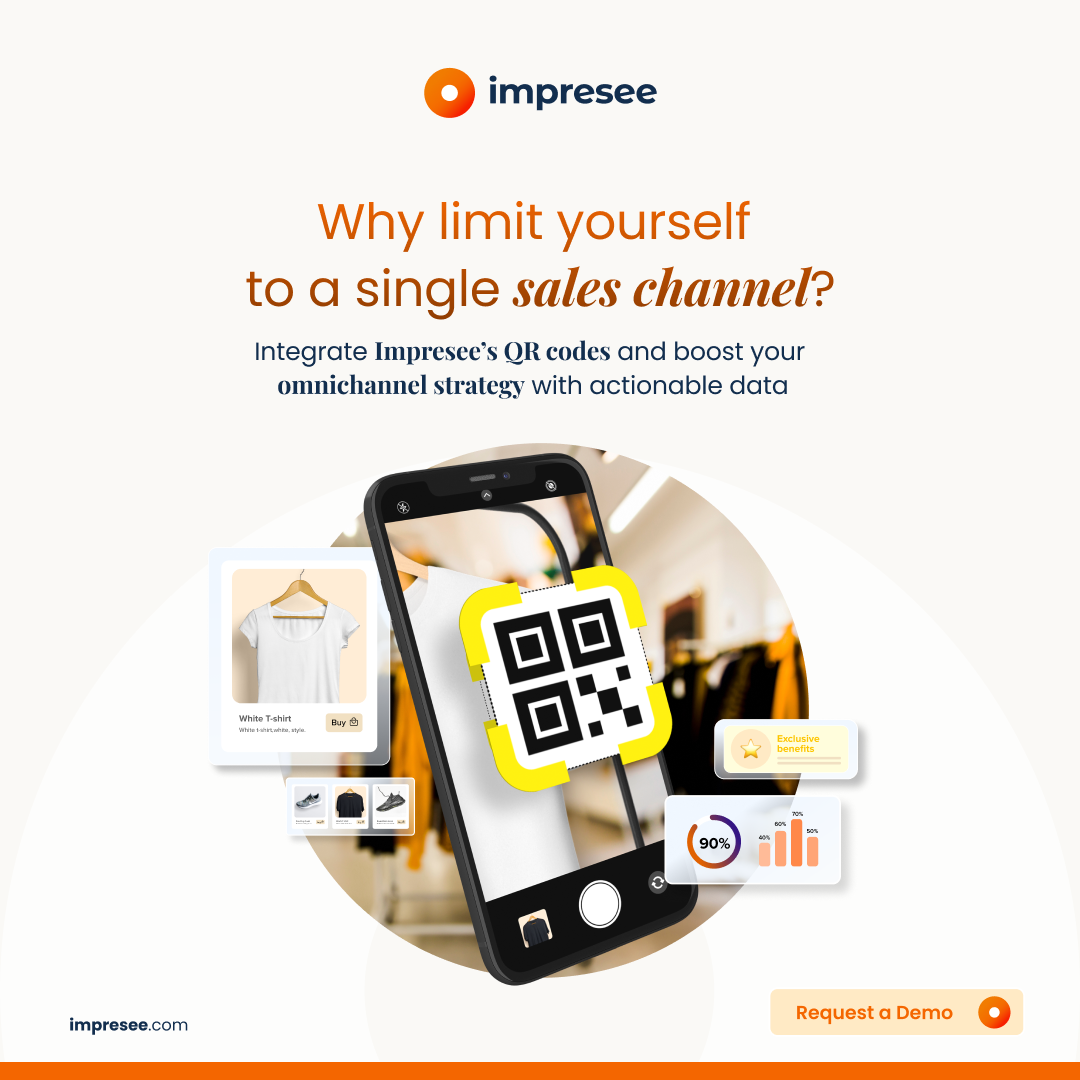In a constantly evolving digital market, anticipating emerging trends is crucial for B2B stores to retain their competitive edge in the future.
The future of B2B e-commerce in 2025 points to a significant transformation, driven by technology, personalization, and a customer-centric approach.
These shifts not only redefine operational strategies but also set new standards for acquiring and retaining customers.
In this blog, we’ll explore the future of B2B e-commerce and the trends shaping 2025.
We’ll analyze their potential impact on your business and discuss how you can refine your strategy to maximize these opportunities.
10 key trends for the future of B2B e-commerce in 2025
1️⃣ Hyper-Automation in B2B Sales
The need for advanced automation is expected to dominate the B2B agenda in 2025, particularly in enhancing the customer buying experience.
A shift from traditional relationship-based sales to a fully integrated digital model is on the horizon.
B2B buyers now expect fast, seamless, and highly personalized shopping experiences.
From lead management to post-sales follow-ups, advanced AI-driven technologies will play a crucial role in boosting efficiency and reducing sales cycle times.
Predictive analytics software is projected to reach a market size of $27.21 billion by 2030.
Leveraging analytics to create hyper-personalized customer interactions is no longer optional—it’s a defining characteristic of successful B2B enterprises across all industries.
2️⃣ Data-Driven Sales and Predictive Analytics
Sales teams are increasingly leveraging high-quality data on purchasing patterns and target segment needs to convert leads into customers.
As a result, big data, predictive algorithms, and AI-powered analytics tools will take center stage in the B2B e-commerce space.
This will enable businesses to anticipate trends, identify sales opportunities, refine strategies, and tailor commercial proposals to customer behaviors and needs.
3️⃣ Product discovery data will be essential
B2B e-commerce platforms will increasingly rely on high-quality data, as buyers pay more attention to personalized recommendations.
This underscores the critical role of data-driven product discovery in influencing purchasing decisions.
Therefore, companies will turn to modular, API-based solutions with flexible data models to enhance access to product discovery insights.
Product discovery data is just as vital on third-party marketplaces as it is on owned channels.
By analyzing what customers are searching for, adding to their carts, and how they navigate the buying process, businesses can deliver tailored experiences and seamlessly increase customer lifetime value.
Understanding their search journey will be invaluable in delivering personalized experiences and will seamlessly increase customer lifetime value.

4️⃣ Social Selling and increased use of Social Media
Traditionally, social media was seen as a tool for B2C businesses, but B2B companies are now harnessing its power like never before.
Social media serves as a powerful channel to build trust with customers by leveraging its accessibility and broad reach.
This is particularly crucial in the B2B sector, where LinkedIn is the top platform for relationship-building, lead generation, and deal closure.
With the help of analytics tools, businesses can more effectively identify their target audience and understand their needs and interests.
75% of B2B buyers report using social media to inform their purchasing decisions.
5️⃣ B2B buyers want self-service buying journeys
Millennial buyers highly value independence, which is why they prefer to manage their purchasing experiences autonomously.
83% of buyers prefer handling their orders and accounts online—a figure that will only continue to rise. (Gartner)
100% of buyers want to manage all or part of their purchase process independently. (TrustRadius)
Key self-service features to implement:
✅ Online portals & dashboards: Customers can easily access personalized dashboards where they can manage accounts, track orders, and reorder seamlessly.
✅ Automated customer support: Implement AI-driven chatbots or automated ticketing systems to guide customers through issue resolution without the need for a representative.
✅ Personalized pricing & catalogs: Offer real-time pricing updates and customized product catalogs.
✅ Simplified ordering: Enable customers to place orders directly on your site with ease.
6️⃣ More B2B organizations will leverage Social Media
B2B e-commerce buyers are expected to use between three and ten digital channels to research products and purchase from sellers, according to Digital Commerce’s 2024 report.
Moreover, B2B buyers rely on social media in various ways to make purchasing decisions:
- Investigate different solutions and understand specific requirements and pain points in the early stages of the sales cycle.
- To compare solutions and evaluate their benefits.
- They need to identify key information before making a final purchase decision.
Choosing the right social media platform for your B2B offerings is crucial for success.
Consider which platforms are most relevant to your audience and which channels provide the best opportunities for engagement with your product.
7️⃣ Marketplaces as key sales channels
The rapid evolution of B2B marketplaces is largely driven by shifting buyer preferences.
Just five years ago, there were only 75 B2B marketplaces, whereas today, there are over 750 industry-specific platforms.
This number continues to rise and is expected to reach 1,000 by 2026. Unsurprisingly, Amazon Business has a dominant presence in the B2B marketplace sector.
In fact, by 2025, Amazon Business is projected to surpass a gross merchandise volume (GMV) of $83.1 billion.
8️⃣ Omnichannel Strategies Will Influence Buying Decisions
In 2024, the average B2B buyer used 10 or more sales channels, a trend that will continue to evolve.
With buyers increasingly relying on digital technologies in the early stages of the sales process, an omnichannel buying experience is now essential for B2B success.
A robust omnichannel strategy requires seamless integration across multiple touchpoints, including in-person sales, hybrid selling, inside sales, digital self-service, and B2B marketplaces.
9️⃣ B2B Organizations Will Become More Tech-Savvy
28% of B2B companies in North America and Europe have recently invested in their e-commerce experience, and one in five global B2B organizations plans to do so in the next year.
This highlights the growing importance of automation, AI-driven solutions, and search optimization technologies in the B2B e-commerce space.
While AI-powered solutions have long been a competitive advantage in B2C e-commerce, they are now delivering tangible results in B2B e-commerce as well.
In 2023, one in four B2B organizations implemented AI in their e-commerce operations, while another 56% reported experimenting with AI but had not yet fully integrated it into their processes.
Likewise, industry leaders recognize the necessity of adopting e-commerce technologies, which drive growth and ensure resilience in fluctuating economic conditions.
🔟 Dynamic Pricing Will Become the Norm
B2B companies are moving away from one-size-fits-all pricing and embracing dynamic pricing strategies based on real-time data.
In 2023, digital commerce platforms accounted for 45% of organizational revenue, a significant increase from 36% in 2019.
Modern B2B buyers seek efficiency, the best value for money, and flexible options rather than relying solely on long-term relationships.
Certainly, today’s B2B marketplaces can manage dynamic pricing alongside customized orders and complex requests, making pricing strategies more sophisticated.
New pricing algorithms now adjust prices based on competition, supply and demand, and even timing, allowing businesses to maximize margins while remaining competitive.
Pricing strategies range from cost-plus-margin models to value-based pricing, giving suppliers greater flexibility in responding to market fluctuations.
How to implement these trends in your B2B e-commerce
Adopting these trends isn’t just about keeping up—it’s about ensuring your business stays agile and competitive in the evolving e-commerce landscape.
From investing in advanced technology to enhancing the customer experience, each trend presents an opportunity to stand out from the competition and drive business growth.
A smart search solution like Impresee’s Smart Search Bar turns these challenges into a competitive advantage.
With B2B e-commerce becoming increasingly competitive and dynamic in 2025, staying ahead requires identifying key trends and acting swiftly and strategically.
✅ Stay Informed
✅ Train your team
✅ Make innovation a core part of your e-commerce strategy
🚀 Ready to take your business to the next level? Prepare for a 2025 full of opportunities!



